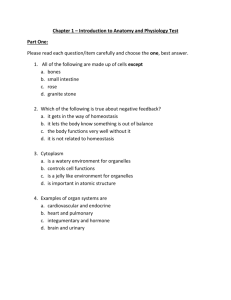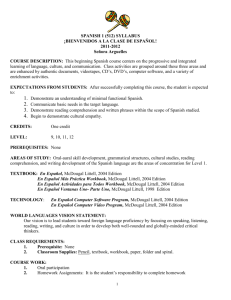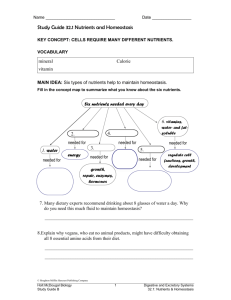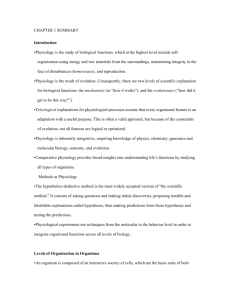Chapter 28 handouts from Biology Book
advertisement
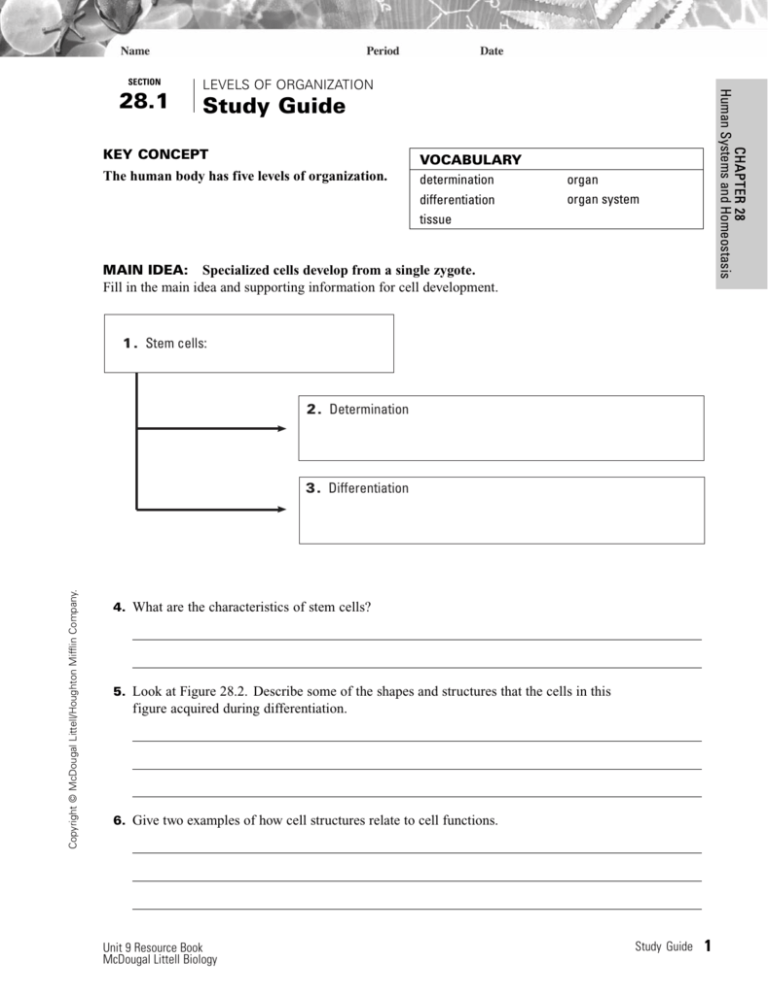
SECTION CHAPTER 28 Human Systems and Homeostasis 28.1 LEVELS OF ORGANIZATION Study Guide KEY CONCEPT The human body has five levels of organization. VOCABULARY determination differentiation tissue organ organ system MAIN IDEA: Specialized cells develop from a single zygote. Fill in the main idea and supporting information for cell development. 1. Stem cells: 2. Determination Copyright © McDougal Littell/Houghton Mifflin Company. 3. Differentiation 4. What are the characteristics of stem cells? 5. Look at Figure 28.2. Describe some of the shapes and structures that the cells in this figure acquired during differentiation. 6. Give two examples of how cell structures relate to cell functions. Unit 9 Resource Book McDougal Littell Biology Study Guide 1 CHAPTER 28 Human Systems and Homeostasis STUDY GUIDE, CONTINUED MAIN IDEA: Specialized cells function together in tissues, organs, organ systems, and the whole organism. 7. Write a description of each level of organization and draw a sketch to help you remember it. Description Sketch Vocabulary Check 8. There is an easy way to remember the difference between determination and differentiation. Look at the first part of each word. Explain how these word parts can help you remember the meaning of each term. 2 Study Guide Unit 9 Resource Book McDougal Littell Biology Copyright © McDougal Littell/Houghton Mifflin Company. Level of Organization SECTION CHAPTER 28 Human Systems and Homeostasis 28.1 LEVELS OF ORGANIZATION Power Notes Steps in Cell Specialization 1. can become any of 200 types of cells in human body. 5. Examples: 2. 4. 3. Example: Five Levels of Organization 10. Copyright © McDougal Littell/Houghton Mifflin Company. Definition: 9. Definition: 8. Definition: 7. Definition: 6. Definition: Unit 9 Resource Book McDougal Littell Biology Power Notes 3 CHAPTER 28 Human Systems and Homeostasis SECTION 28.1 LEVELS OF ORGANIZATION Reinforcement KEY CONCEPT The human body has five levels of organization. Humans, like all multicellular organisms, are made up of specialized cells that work together. These cells arise from a single cell, the zygote, which divides to form embryonic stem cells. Stem cells can become any one of more than 200 different types of cells. Cell specialization involves determination and differentiation. Determination occurs when stem cells commit to become only one type of cell, such as a muscle cell. Committed cells still retain all the genetic information needed to build an entire organism. Differentiation is the process by which committed cells acquire the structures and functions of highly specialized cells. For example, a skeletal muscle cell acquires a nucleus and a long body. Programmed cell death, or apoptosis, is also an important part of developing individual structures such as individual fingers or toes. The human body has five levels of organization. • Specialized cells are characterized by their specific structures and functions. • A tissue is a group of similar cells that work together to perform a specialized function. Four tissue types are epithelial, connective, muscle, and nervous tissue. • An organ is a structure composed of different types of tissues that function together. • An organ system is two or more organs working together in a coordinated way. • An organism is made up of all the organ systems that work together to support life. What affects one organ or organ systems can affect all organs or organ systems. The human body is made up of 11 organ systems. Copyright © McDougal Littell/Houghton Mifflin Company. 1. Which kind of cells can become any type of cell in the body? 2. What is the difference between determination and differentiation? 3. Label each item in the list below according to its level of organization. Item Level of Organization lungs heart and blood vessels red blood cells skeletal muscle human being 4 Reinforcement Unit 9 Resource Book McDougal Littell Biology SECTION Study Guide KEY CONCEPT Homeostasis is the regulation and maintenance of the internal environment. MAIN IDEA: CHAPTER 28 Human Systems and Homeostasis 28.2 MECHANISMS OF HOMEOSTASIS VOCABULARY homeostasis feedback negative feedback positive feedback Conditions within the body must remain within a narrow range. 1. Give two reasons why it is so important that the internal environment of the body remains stable. 2. Homeostasis is maintained by control systems. Fill in the name and function of the parts Copyright © McDougal Littell/Houghton Mifflin Company. of the control system in the cycle diagram below. Sensors Control center Targets Communication system 3. What might happen if a target organ cannot respond? Unit 9 Resource Book McDougal Littell Biology Study Guide 5 CHAPTER 28 Human Systems and Homeostasis STUDY GUIDE, CONTINUED MAIN IDEA: Negative feedback loops are necessary for homeostasis. 4. Study the following line drawings. Which of the following diagrams represents negative feedback and which represents positive feedback? Explain your answer. A. B. 5. It’s a hot day and you’re sweating. Is this response an example of a positive or negative feedback loop? Explain your answer. Explain briefly how your control systems act to bring more oxygen into your body. Vocabulary Check 7. What is the difference between positive and negative feedback loops? 8. Think of an analogy that would illustrate the process of feedback for someone who does not know what the word means. 6 Study Guide Unit 9 Resource Book McDougal Littell Biology Copyright © McDougal Littell/Houghton Mifflin Company. 6. When you run, your muscles require more oxygen as their level of activity increases. SECTION CHAPTER 28 Human Systems and Homeostasis 28.2 MECHANISMS OF HOMEOSTASIS Power Notes Control Systems and Feedback Loops Control center’s function: Target’s function: Communication system’s function: Copyright © McDougal Littell/Houghton Mifflin Company. Sensor’s function: Unit 9 Resource Book McDougal Littell Biology Power Notes 7 CHAPTER 28 Human Systems and Homeostasis SECTION 28.2 MECHANISMS OF HOMEOSTASIS Reinforcement KEY CONCEPT Homeostasis is the regulation and maintenance of the internal environment. Conditions within the body must remain within the narrow limits that support life. These conditions include fluid balance, internal body temperature, levels of trace minerals, and so on. Homeostasis is the regulation and maintenance of the internal environment. The body has many control systems that keep its internal environment stable. Control systems are composed of four parts. • Sensors gather information about internal and external conditions. For example, sensors in the skin gather information about air temperature. • A control center receives information from the sensors, compares it to set points, or ideal values, and responds by sending messages through a communication system. • The nervous and endocrine systems act as communication systems. Nerve impulses or hormones are messages sent to targets throughout the body. • Targets are organs, tissues, or cells that respond to messages. The parts of a control system work together in what is known as a feedback loop. Feedback is information from sensors that allows a control center to compare current conditions to a set of ideal values. Negative feedback loops counteract any change that moves conditions above or below a set point. For instance, if your fluid balance falls below a set point, your brain sends signals that cause you to drink more. Positive feedback loops increase change away from set points. In an emergency, for example, adrenaline pours into your system to give you more strength until the emergency is over. 2. Name the four parts of a control system. 3. Your stomach is growling in hunger. Is this signal part of a positive or negative feedback loop? Explain. 4. A friend tells you that people can hold their breath until they die. Use your knowledge of homeostasis and control systems to explain why this is highly unlikely to happen. 8 Reinforcement Unit 9 Resource Book McDougal Littell Biology Copyright © McDougal Littell/Houghton Mifflin Company. 1. What is homeostasis? SECTION Study Guide KEY CONCEPT Systems interact to maintain homeostasis. MAIN IDEA: CHAPTER 28 Human Systems and Homeostasis 28.3 INTERACTIONS AMONG SYSTEMS VOCABULARY thermoregulation Each organ affects other organ systems. 1. The organs in the body work together like members of a pit crew servicing a race car. What other analogies can you think of to illustrate organ systems working together? 2. Fill in the table below to explain what each organ does to help produce vitamin D in your body. Organ Function Skin Liver Copyright © McDougal Littell/Houghton Mifflin Company. Kidneys 3. What role does the hypothalamus play to help regulate body temperature? MAIN IDEA: A disruption of homeostasis can be harmful. 4. List three reasons why homeostasis in the body might be disrupted. Unit 9 Resource Book McDougal Littell Biology Study Guide 9 CHAPTER 28 Human Systems and Homeostasis STUDY GUIDE, CONTINUED 5. Why is a long-term disruption of homeostasis usually more serious than a short-term disruption? Fill in the concept map to help you remember what you know about long-term and short-term disruption of homeostasis. Disruption of homeostasis can be 9. 6. usually leads to 10. damage to many organs over time example example 11. 8. Vocabulary Check 11. Think of a diagram that might illustrate the term thermoregulation for someone unfamiliar with the word. Use the space below to sketch your diagram. 10 Study Guide Unit 9 Resource Book McDougal Littell Biology Copyright © McDougal Littell/Houghton Mifflin Company. 7. can lead to SECTION CHAPTER 28 Human Systems and Homeostasis 28.3 INTERACTIONS AMONG SYSTEMS Power Notes Copyright © McDougal Littell/Houghton Mifflin Company. Organs Working Together: Thermoregulation Sensors Control Center Function: Sensors in skin and blood vessels detect a rise in temperature in the blood; send information to control center. Response: Targets Communication System Response: Function: Disruption of Homeostasis two types 1. can produce these effects 2. Unit 9 Resource Book McDougal Littell Biology 3. can produce these effects 4. Power Notes 11 CHAPTER 28 Human Systems and Homeostasis SECTION 28.3 INTERACTIONS AMONG SYSTEMS Reinforcement KEY CONCEPT Systems interact to maintain homeostasis. In the human body, all of the organs interact with one another, regulated by feedback mechanisms. Each organ system communicates with other organ systems through chemical messages and nerve impulses. For example, in vitamin D production, the skin, circulatory system, liver, kidneys, and endocrine system all work together to produce a form of vitamin D the body can use to build strong bones. If any organ fails to do its job, the level of vitamin D in the body decreases. Interaction among organs is also important in thermoregulation. Maintaining a steady internal body temperature requires the coordination of the skin, hypothalamus, circulatory and respiratory systems, muscular system, and nervous and endocrine systems. Sensors from the skin and blood vessels send information to the hypothalamus, which then sends messages through the nervous and endocrine systems to the sweat glands, respiratory and circulatory systems, and muscle systems. Homeostasis can be disrupted for several reasons, such as change occurring too rapidly, target organs failing to respond to signals, or disease changing the body’s chemistry. A disruption of homeostasis can begin in one organ or organ system and result in a chain reaction that affects other organs and organ systems. These effects can be short term or long term. The common cold, for instance, will disrupt homeostasis for only a few days. Chronic conditions such as diabetes, however, represent a long-term disruption that can result in the failure of several organs. 2. How do organs and organ system communicate with one another? 3. What organ systems interact to maintain a steady internal body temperature? 4. What is the effect on the body of a short-term disruption of homeostasis? of a long-term disruption? 12 Reinforcement Unit 9 Resource Book McDougal Littell Biology Copyright © McDougal Littell/Houghton Mifflin Company. 1. Why it is important that organs and organ systems in the body work closely together? CHAPTER 28 Data Analysis Practice Many times a relationship between two variables becomes easy to see when data collected from an experiment is graphed. Classifying the relationship between variables is part of data analysis and drawing conclusions. Sometimes athletes, such as triathletes and ultradistance runners, develop a condition in which they do not have enough sodium (Na) after extreme physical exercise and a large intake of fluids. Scientists wanted to understand more about how the low sodium condition develops. They collected data on how the amount of extracellular sodium changed as athletes at rest consumed fluids. Fluid retention levels were measured as changes in body weight (in kilograms) of the athletes. The graph below shows the results of the study. CHAPTER 28 Human Systems and Homeostasis INTERPRETING GRAPHS: INVERSE RELATIONSHIPS GRAPH 1. SODIUM CHANGE AND FLUID LEVELS Sodium levels (mEq/L) 137 135 133 131 129 127 125 0 0 .5 1 1.5 2 2.5 Change in weight (kg) 3 Explain the relationship between sodium change and fluid levels (measured as changes in body weight). Copyright © McDougal Littell/Houghton Mifflin Company. 1. Identify 2. Conclude Can you conclude that taking in large of fluids causes the amount of sodium to lower? Why or why not? Unit 9 Resource Book McDougal Littell Biology Data Analysis Practice 13 CHAPTER Pre-AP* Activity *Pre-AP is a registered trademark of the College Board, which was not involved in the production of and does not endorse this product. You have learned in Chapter 28 that embryonic stem cells become committed to developing into a specific type of cell soon after the zygote is formed. This commitment, called cell determination, takes place on a molecular level long before the observable changes of cell differentiation occur. MOLECULAR BASIS OF CELL DETERMINATION CHAPTER 28 Human Systems and Homeostasis 28 DETERMINATION OF MUSCLE CELLS How does an embryonic stem cell commit to becoming a muscle cell? Researchers have identified several key muscle-determination genes. When one or more of these master regulatory genes is expressed—that is, transcribed and translated––a stem cell becomes committed to forming a skeletal muscle cell. One such master regulatory gene is myoD. When myoD is expressed, the protein MyoD is produced. This protein is a powerful transcription factor that binds to noncoding DNA and causes transcription of other regulatory genes. These genes produce proteins that also act as transcription factors. At the end of the chain of control proteins, genes that code for muscle proteins are transcribed and translated. Experiments have shown that when MyoD protein is added to differentiated liver or fat cells, they become muscle cells. Copyright © McDougal Littell/Houghton Mifflin Company. MOLECULAR BASIS OF DIFFERENTIATION Differentiation of a cell occurs when genes that code for tissue-specific proteins are expressed. Tissue-specific proteins are found only in a certain kind of cell and give that cell its characteristic structure and function. For example, skeletal muscle cells contain myosin and actin, proteins that interact in muscle cells to make a muscle fiber contract. Myosin and actin are muscle-specific proteins. Expression of the genes for myosin and actin occurs at the end of the control-protein chain that begins with MyoD. The final control genes are transcribed and translated. The committed cell, now called a myoblast, begins to produce large quantities of muscle-specific proteins—myosin and actin. In a short time, the cell is recognizable as a muscle cell. CYTOPLASMIC DETERMINANTS An obvious question that has not been answered about the formation of a muscle cell is what causes the myoD gene to be expressed in the first place. What starts the determination process in the early embryo? Scientists think that it all starts in the egg prior to fertilization. The cytoplasm of an egg cell is not uniform. Organelles, proteins, and mRNA—called maternal cytoplasmic determinants—are distributed unevenly in the egg. There may be a large amount of a certain maternal protein in one area and none in another area. Organelles may be clustered together in some regions but dispersed widely in others. After the egg is fertilized, it begins to divide. As a result of the uneven distribution of maternal cytoplasmic determinants, the nuclei in the daughter cells are surrounded by different cytoplasmic environments. These differences play a critical role in determining which genes will be expressed and what the fate of the cell will be. Unit 9 Resource Book McDougal Littell Biology Pre-AP* Activity 15 A second factor that plays an important role in determining what genes are expressed is the interaction of cells in the developing embryo. An embryonic cell receives chemical signals from the cells surrounding it. The signal molecules cause changes in the gene expression in the target cell, a process called induction. These interactions among embryonic cells are eventually responsible for the differentiation of all the different kinds of cells in the organism. 1. Create a sequence diagram showing how an uncommitted embryonic stem cell in a zygote becomes a muscle cell in an embryo. Begin the flow diagram by showing the factors that influence gene expression in an unfertilized egg cell, and end it with a differentiated skeletal muscle cell. Use the labels Differentiation, Determination, Cytoplasmic Determinants, and Induction in your diagram. 2. In vitro fertilization is a procedure in which human eggs are fertilized in a petri dish and then implanted in a woman’s uterus so she can give birth to a baby. Human embryonic cells become committed when the embryo has eight cells. What would happen if a cell were removed from a four-cell embryo and implanted into a woman’s uterus? What would happen if a cell were removed from a 32-cell embryo and implanted? Explain. 16 Pre-AP* Activity Unit 9 Resource Book McDougal Littell Biology Copyright © McDougal Littell/Houghton Mifflin Company. CHAPTER 28 Human Systems and Homeostasis INDUCTION CHAPTER Pre-AP Activity Between the years of 1979 and 2002, 16,555 deaths in the United States were attributed to exposure to excessive cold. These deaths resulted from the victims’ inability to maintain a stable internal body temperature. In this activity you will learn how the human body regulates body temperature, loses body heat to the environment, and why hypothermia occurs. REGULATION OF BODY TEMPERATURE To maintain homeostasis, the human body must be able to generate, retain, and discharge heat depending on its activity level and the ambient (surrounding) temperature. The hypothalamus regulates body temperature. It is sensitive to the smallest temperature changes in the blood (0.5 °C) and nerve impulses received from the nerve endings in the skin. When body temperature increases or decreases too much, the hypothalamus signals the body to respond. Vasodilation increases blood flow to the surface of the skin. The average rate of cutaneous blood flow is 300–500 mL/min, but vasodilation can increase it up to 3000 mL/min. This increases heat loss. Vasoconstriction decreases blood flow to the periphery (arms, legs, skin, muscle tissue) from 300–500 mL/min to 30 mL/min. This decreases heat loss from the body. Shivering can increase surface heat production by 500 percent, but it is limited to a few hours due to energy expenditure and fatigue. Sweat cools the body through evaporation. Behavioral responses, such as increasing or decreasing activity levels, seeking shade, and adding or removing layers of clothing, can also help. CHAPTER 28 Human Systems and Homeostasis 28 THE DANGERS OF COLD EXPOSURE Copyright © McDougal Littell/Houghton Mifflin Company. HEAT LOSS TO THE ENVIRONMENT There are four main ways that the human body can lose heat to the environment: radiation, conduction, convection, and evaporation. Body heat is lost through radiation when the ambient temperature is lower than the temperature of the body, about 98.6 °F. Conduction causes heat loss when the body is in direct contact with a colder object, allowing for the molecular transference of heat energy. Conduction is 32 times greater in water than in air due to water’s greater density. Convection is a form of conduction where an object or the surrounding substance is in motion, as with the air blowing down from a ceiling fan. Heat is lost through evaporation when water is converted from a liquid to a gas. If too much heat is lost from the body and the internal temperature drops below 36.7 °C (98.2 °F), hypothermia and death can occur. HYPOTHERMIA Hypothermia occurs when the internal body temperature decreases to a level where cerebral and muscular function becomes impaired. As the core temperature drops, metabolic function and oxygen consumption decrease. Hypothermia can be caused by cold temperatures, inadequate clothing, wetness, fatigue, dehydration, and insufficient caloric intake. Caffeine and alcohol consumption can also help cause or intensify hypothermia. Caffeine is a diuretic which can increase dehydration; alcohol causes vasodilation and impairs shivering, hypothalamic functioning, and awareness of one’s surroundings. The young and the elderly are the most at risk for developing hypothermia. Young children are not able to generate as much heat as adults and they lose heat more easily because they have a larger body surface in relation to their total mass. The elderly have a lower metabolic rates, making it difficult for them to generate heat and maintain a stable body temperature. Unit 9 Resource Book McDougal Littell Biology Pre-AP Activity 17 CHAPTER 28 Human Systems and Homeostasis 1. To conserve body heat, vasoconstriction restricts blood flow to the periphery but not to the body’s core. Explain how this is an adaptation for survival. 2. Suppose a mountain climber who has been climbing all day gets trapped on a cliff at sunset. The winds start to pick up, so the climber sits down in an effort to shelter the body. Cite three types of heat loss this mountain climber could experience. 3. It is not uncommon for people to become hypothermic even in locations with mild weather. Explain a situation in which this is possible. 4. Suppose that while hiking you encounter a person you believe to be mildly or moderately 5. While treating the hypothermic individual, you remember that you have a thermos filled with hot coffee in your backpack. Should you offer them some? Explain your reasoning. 18 Pre-AP Activity Unit 9 Resource Book McDougal Littell Biology Copyright © McDougal Littell/Houghton Mifflin Company. hypothermic. Identify four actions you could take to treat that individual. CHAPTER Vocabulary Practice determination organ feedback positive feedback differentiation organ system negative feedback thermoregulation tissue homeostasis A. Words in Context Answer the questions to show your understanding of the vocabulary words. CHAPTER 28 Human Systems and Homeostasis 28 HUMAN SYSTEMS AND HOMEOSTASIS 1. Which of these two involves feedback: sensors providing information about oxygen needs or oxygen entering red blood cells? 2. In thermoregulation, is a body maintaining a stable range of temperature or is it merely producing an increase in temperature? 3. When you talk about an organ system are you talking about different organs working together or different functions within an organ working together? 4. Would positive feedback or negative feedback increase changes away from set values? Copyright © McDougal Littell/Houghton Mifflin Company. 5. Which is more like homeostasis: an oven maintaining a set temperature or a pot of water starting to boil? 6. When a lung cell has acquired hairlike cilia, has it gone through differentiation or determination? 7. Is a muscle fiber an example of a tissue or an organ? 8. Is thermoregulation the process of maintaining a stable body temperature or of producing body heat so cells can function? Unit 9 Resource Book McDougal Littell Biology Vocabulary Practice 19 CHAPTER 28 Human Systems and Homeostasis VOCABULARY PRACTICE, CONTINUED B. Vector Vocabulary Define the words in the boxes. On each arrow, write a phrase that describes how the words in the boxes are other. 1. DETERMINATION 2. 3. More complex structures form. 4. Similar cells work together to perform special functions. 8. HOMEOSTASIS 7. Different organs work together to perform functions. Conditions require change. 9. 20 Vocabulary Practice Conditions maintained despite change. 10. Unit 9 Resource Book McDougal Littell Biology Copyright © McDougal Littell/Houghton Mifflin Company. 6. C. Stepped-Out Vocabulary Define each word. Then write two additional facts that are related to the word. WORD DEFINITION MORE INFORMATION Example feedback information used to compare current conditions to a set of ideal values negative and positive feedback loops regulate change most functions are regulated by negative feedback CHAPTER 28 Human Systems and Homeostasis VOCABULARY PRACTICE, CONTINUED 1. differentiation Copyright © McDougal Littell/Houghton Mifflin Company. 3. organ D. Categorize Words Write T next to words that can describe tissues. Write O next to words that can describe organs. Write OS next to words that can describe organ systems. 1. 2. muscle all bones in the body nerve lung skin stomach lining liver heart brain, spinal cord, nerves blood tendon thymus, spleen, white blood cells Unit 9 Resource Book McDougal Littell Biology Vocabulary Practice 21 CHAPTER 28 Human Systems and Homeostasis VOCABULARY PRACTICE, CONTINUED E. Who Am I? Choose among these terms to answer the riddles below: determination tissue organ system feedback positive feedback differentiation organ homeostasis negative feedback thermoregulation 1. I’m like a team: the players have different roles, but we’re all part of the same group. 2. When you ask someone to review your speech, you’ve asked for me. 3. I prevent your body from changing too much, like a guidance system that keeps a ship on course. 4. My four different types make up every organ in the body. 5. If I’m not maintained, then critical processes in the body start breaking down. 6. I’m like a manager of a team giving each person special equipment to use. 7. When you get cut, you definitely want me there changing things quickly to stop the bleeding. Copyright © McDougal Littell/Houghton Mifflin Company. F. Draw a Cartoon Draw a cartoon or diagram that illustrates three of the vocabulary words, such as determination, differentiation, and tissue. You can include dialogue or a caption for your cartoon. 22 Vocabulary Practice Unit 9 Resource Book McDougal Littell Biology

